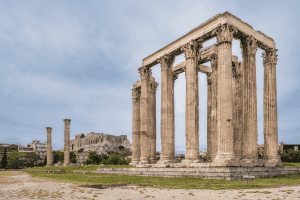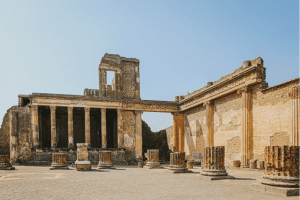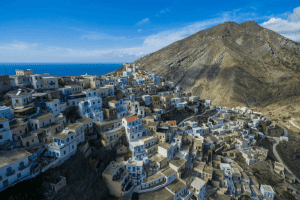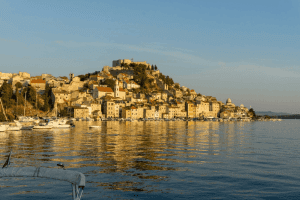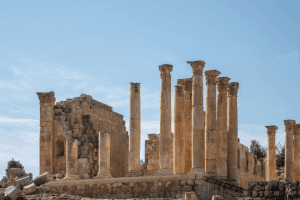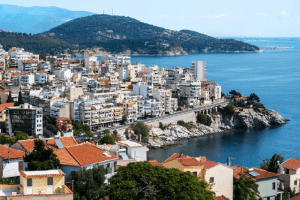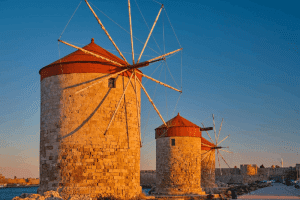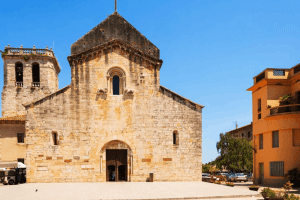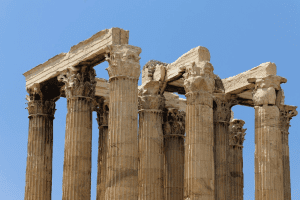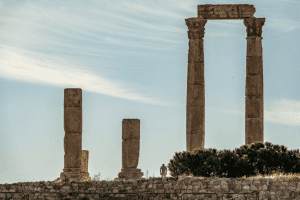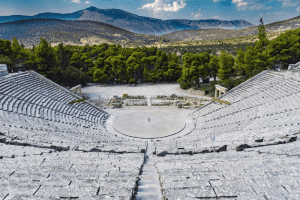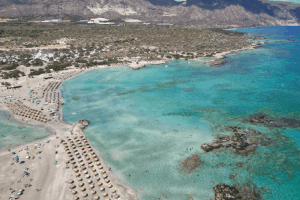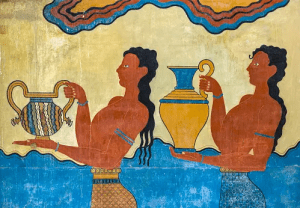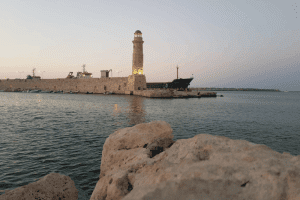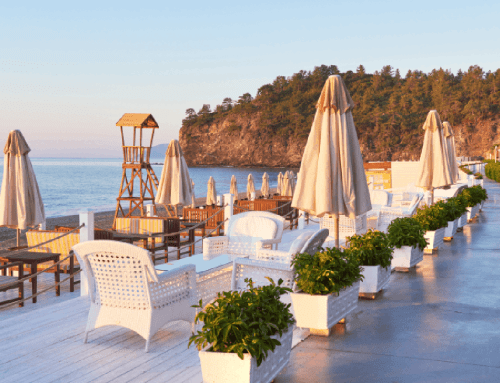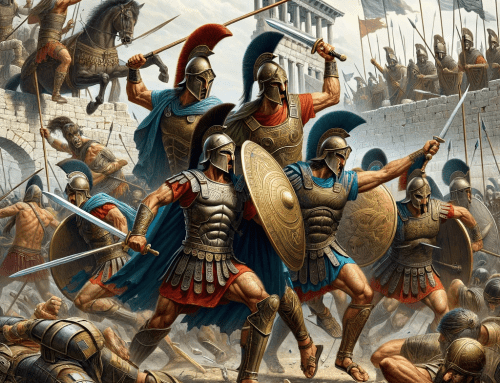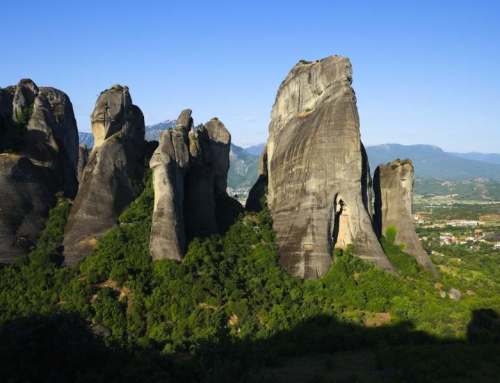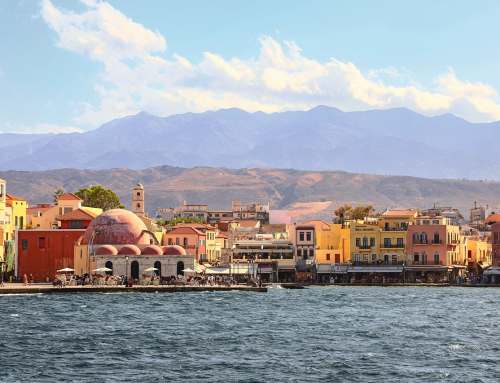Greece, the cradle of Western civilization, whispers of ancient myths and beckons with sun-kissed shores. The place is widespread from the towering Acropolis to the sapphire Aegean. Every corner of this land bursts with adventure and beauty.
Table of Contents
What to Do in Greece?
Explore Mykonos, discover the Samaria Gorge, ascend Mount Olympus, take in the sunset in Santorini, visit the Acropolis, unwind on breathtaking Beaches, and more. Explore Thessaloniki, visit the stunning island of Zakynthos, have dinner and enjoy the nightlife, spend the evening watching Rebetiko, and much more.
Greece presents a vivid picture of its history, culture, and natural beauty, enticing everyone to visit. Everyone is sure to feel at home here, whether they are history or adventure enthusiasts. There is never a shortage of things to do in Greece.
Greece has several historical monuments worth seeing for those who want to learn more about its mysterious past. The most well-known locations include the Acropolis, the Temple of Hephaestus, and the Oracle of Delphi.
On the other hand, water activities are among the most liked things to do in Greece, so adventure seekers will feel right at home trying their luck at extreme sports at the countless beaches scattered around the islands.
If you want to take a more relaxed trip, you can always visit an outdoor theater in Athens, try cocktails at a rooftop bar, or take in one of Santorini’s breathtaking sunsets.
Land of Gods and Historical Ruins
Greece has something for everyone, including the longest coastline in the Mediterranean, a forested interior, ancient towns, time-capsule villages, and around 6,000 islands.
Enthusiasts of history and touring adore the museums and temples of Athens’ Acropolis, Meteora’s rock monasteries, Delphi and Olympia’s antiquities, and the Palace of Knossos in Crete. However, whether you’re on the mainland or one of the islands, slow-motion sports are some of the most incredible things to do in Greece.
Each and every place in Greece has historical and modern value that has everyone’s heart. So, pack your sunscreen and prepare to be dazzled because we’re diving into the top things to do in Greece:
A) Things To Do In Athens, Greece
The largest city and capital of Greece is Athens. With nearly 3,400 years of recorded history, it is among the oldest cities in the world. Athens is renowned for its extensive historical background, historic sites, and contributions to democracy, philosophy, and Western civilization.
1) Agora of Athens
One of the most significant archeological sites in the nation’s capital is the Agora, the ancient city of Athens’ political and social hub, which now remains a marketplace and civic center. Uncover this birthplace of Greek democracy, which includes the Attalos Stoa and the Temple of Hephaestus.
The world’s best-preserved example of an agora from antiquity is thought to be the Agora of Athens. For professional interpretation of these ruins, which can be challenging to understand independently, go with a guide.
The hop-on-hop-off bus and the archaeological site’s downloadable audio guide provide independent guests with more information and transportation.
Take a personalized or small-group walking tour, including admission to the Agora Museum and skip-the-line tickets, essential for these well-known and packed ruins.
Alternatively, choose a tour that combines a visit to the Acropolis and the Agora. If you are going with children, look for a family-oriented tour. Our guides are experts at bringing the place to life for smaller visitors.
2) Erechtheion, Athens
The elaborate Porch of the Caryatids, supported by marble sculptures of six virgins, is the most notable feature of the Erechtheion, one of the most impressive ancient ruins of the UNESCO-listed Acropolis.
The temple, which dates to the 5th century BC, is supposed to be the location of the battle between Poseidon and Athena for dominance of the newly established city of Athens.
The most well-known classical structure in the world, the Acropolis (whose name means “high city” in ancient Greek), is perched on a rocky escarpment overlooking the center of Athens and is classified as a UNESCO World Heritage structure.
The marble remnants of the Erechtheion, which stood at the center of the Acropolis and are currently among its most well-known sites, can be the first stop for most tourists after visiting the colonnaded Parthenon.
Take a guided tour of Athens to learn about the history and architecture of the Erechtheion and other historical monuments on the Acropolis, or go it alone with a pre-purchased skip-the-line ticket to avoid standing in line.
A digital audio tour is often included with fast-track tickets to help you understand the ruins.
3) Acropolis of Athens
You start your journey in Athens, the city of history. One of the most popular tourist destinations in Greece is the Acropolis complex, which is included in most tours of the city of Athens.
It’s often paired with a visit to the New Acropolis Museum or other monuments from Ancient Greece, like the Temple of Poseidon, Epidaurus, and Cape Sounion. A guided city walking tour is the best way to see the ruins, and it includes stops at famous sites, including the Parthenon, Propylaea (also known as Propylaia), the Temple of Athena Nike, and the Erechtheion.
Climb the holy Acropolis and gaze in wonder at the Parthenon, a representation of the democracy in Athens. Discover the intricate Plaka area and immerse yourself in the lively Agora, the historical discussion venue for philosophers. Don’t miss the Acropolis Museum, a treasure trove of ancient artifacts.
4) Acropolis Museum
The Acropolis Museum is a modern architectural marvel and a famous landmark in Athens. It is located at the foot of the Acropolis, and its floor allows visitors to see the remains of an old structure.
Explore the Acropolis Museum (Museo Akropoleos) to view original artifacts from the Acropolis temples preserved from further deterioration and displayed alongside historical information.
See a replica of the renowned marble frieze in the Parthenon Gallery. Explore the Archaic Gallery to see statues that precede the Acropolis itself, and the Gallery of the Slopes to see pots, kid’s toys, and other artifacts used by the first settlers.
A skip-the-line ticket might save time during busy tourist seasons like summer and Easter. The Acropolis Museum is a well-liked destination on Athens history excursions, but it’s also open for personal exploration. The ideal way to learn about the sights of the Acropolis is with a tour of the Acropolis Museum.
5) Parthenon, Acropolis
Landed on the sacred rock of Acropolis, high above the modern city, is the Parthenon, the focal point of postcards depicting Athens and perhaps the most impressive of all the city’s ancient ruins.
Walking tours of the Acropolis of Athens, which include nearby remains like the Propylaea, the Temple of Athena Nike, and the Erechtheion, are the ideal way to see the Parthenon.
Those visiting Athens for the first time can also add on a sightseeing tour, a half-day excursion to Cape Sounion and the Temple of Poseidon, or even a city tour focusing on gastronomy. A visit to the New Acropolis Museum or an excursion to the Ancient Agora are optional activities for history buffs.
B)Things To Do In Santorini, Greece
Famous Greek island Santorini is situated in the southern Aegean Sea. It is recognized for its breathtaking scenery, blue-domed, white-washed houses, crystal-clear seas, and breathtaking sunsets.
1) Oia, Santorini
Oia is known for its romantic sunsets and perched on the caldera’s sharp edge, overlooking the shimmering Mediterranean. Oia is also one of the most gorgeous villages of Santorini, known for its spectacular white buildings, blue-domed churches, and dramatic cave houses tucked into the volcanic rock.
Most boat cruises, shore excursions, and sightseeing tours of Santorini include a stop at Oia, usually scheduling their visit to coincide with the sunset.
Combine a visit to Oia with other attractions, such as a wine tasting in Santorini, traditional villages like Pyrgos or Fira, or the archeological site of ancient Akrotiri or the Monastery of Profitis Ilias.
As an alternative, go sailing around the island of Thirassia, go snorkeling at Red Beach, or relax in the hot springs on the island of Nea Kameni. After that, take a sunset boat past Oia.
2) Santorini Volcano
Most visitors take a boat trip that leaves from the village of Oia, the Old Port of Fira, or the Athinios port on the main island of Santorini to reach the active volcano on Nea Kameni, whose crater continues to shake and puff up steam.
Once on the island, visitors can trek up to the crater rim to see Greece’s Aegean Sea beyond lava fields. Volcano excursions can also include stops at the hot springs on Palea Kameni, where boats moor at Erinia, and you can swim to the springs beneath the little church of Agios Nikolaos and on Thirasia, the second biggest island in the archipelago.
3) Red Beach, Santorini
Red Beach on Santorini is not your typical white-sand paradise. Instead, it’s a slender, rocky area ringed by towering crimson cliffs and dotted with massive volcanic boulders. Photographers are drawn to the Aegean Sea’s coasts by the beautiful natural color palette created by these volcanic features and the crystal blue color of the sea.
Red Beach is a cherished location for swimming and tanning, but it can also be dangerous due to occasional landslides and falling rocks. As a result, many guests would instead take in the beach from a distance, either from the sea itself or from the parking lot that faces the beach.
Several paddling tours and catamaran cruises, some of which include food and beverages on board, pass by the beach. Some day trips from Santorini include visiting the neighboring ancient Akrotiri archaeological site, an excavated Bronze Age Minoan settlement, and a beach excursion.
4) Akrotiri, Santorini
The Bronze Age settlement of Akrotiri was abruptly destroyed by a cataclysmic volcanic eruption that covered it in a layer of ash around 1613 BC. Excavations of the Minoan town started in 1967 and turned up structures, drainage systems, and ceramics. Still, no human bones or riches made of gold, suggesting that the residents had time to escape before the calamity struck.
Ancient Akrotiri, the island’s most significant historical landmark, is often visited on bus, minivan, or private vehicle tourist trips. Even while you can tour the hamlet alone, going with a guide who can give you some background on the ruins is more gratifying.
Akrotiri guided visits are combined with tours to other scenic Greek towns and villages, like Oia, Pyrgos, Megalochori, and Emporio. Free time for swimming, sunbathing at locations like Perissa Beach or Red Beach, and wine tastings on some Santorini tours.
5) Pyrgos, Santorini
Perched atop a volcanic crater at the pinnacle of Santorini, this charming settlement offers sweeping views of the island. Pyrgos (Pyrgos Kallistis), with its whitewashed Cycladic buildings, Byzantine churches, and narrow cobblestone alleyways, has the traditional appeal of the Greek islands without the masses of tourists.
With only 700 residents, Pyrgos (Pyrgos Kallistis) is one of the most pictorial towns on the island due to its panoramic location and well-preserved antique architecture, although drawing far fewer tourists than other popular destinations.
Visit these old inland hamlets, such as Exo Gonia and Magelochori, at
Stops to take pictures and explore the old ruins of Kasteli Castle and the frescoed churches. Enjoy the delicious local food that Pyrgos and the surrounding area are known for, so eat at the authentic tavernas and eateries.
C) Things To Do In Chania, Greece
The city of Chania is on the Greek island of Crete’s northwest coast. It is well-known for its ancient buildings, Venetian Harbor, and quaint Old Town.
1) Old Venetian Harbor
For four centuries, Venice dominated Crete, constructing Chania’s scenic port in the fourteenth century. Currently, the Old Venetian Harbor is the vibrant center of Chania Old Town, housing shops, eateries, and bars next to famous buildings like the Hassan Pasha Mosque, Firkas Fortress, and Venetian Lighthouse.
It is crowning its ancient wall with a 70-foot (21-meter) lighthouse and is a charming place to stroll, adorned with vibrant residences and lively tavernas. Many old structures have been carefully renovated.
For example, the Maritime Museum of Crete is currently housed in Firkas Fortress, while events and exhibitions are held in the Ottoman mosque and the Venetian Grand Arsenal.
The harbor is pedestrianized, just like a large portion of Chania Old Town. If you’re not into walking tours, consider traveling by bicycle, Segway, or three-wheeled scooter. A stroll along the waterfront is a part of specific Chania cuisine tours.
2) Venetian Lighthouse, Chania
The most remarkable structure on the town’s Venetian Harbor is the Venetian Lighthouse, which is perched at the extremity of the breakwater. It was built in the 1570s when the Republic of Venice ruled Chania. It is highly photographed in the city due to its fantastic architecture. It is one of the world’s oldest lighthouses.
This delicate, butter-colored stone tower rises to a height of 69 feet (21 meters), and a miniature minaret from the Ottoman Turk era of Crete sits atop it.
Most small-group or private Chania sightseeing trips include visiting it as a highlight. A city tour of Chania is usually combined with visits to Lake Kournas and the town of Rethymno on day tours and shore excursions departing from Heraklion.
In addition to enjoying the bustling traditional tavernas of the Venetian Harbor, Chania food tours that visit these waterfront restaurants also offer views of the historic lighthouse.
Choose from one of the many boat tours and mini-cruises that pass the lighthouse along the Crete coastline to explore Elafonisi Beach, or go to the surrounding islands of Theodorou, Glaronisi, and Lazaretto for an incredibly panoramic view.
3) Archaeological Museum of Chania
Thanks to its collection of artifacts discovered during excavations around the town and throughout western Crete, the Archaeological Museum of Chania allows history buffs to follow the history of Crete from the Neolithic and Minoan to the late Roman era. One of the highlights of Chania’s old town is the museum, housed in the medieval Church of St. Francis.
Located in the core of the town’s historic district in a magnificently restored 16th-century church, the Archaeological Museum of Chania boasts equally impressive architecture as its collection.
Take a walking, biking, Segway, or Trikke tour of Chania to see the museum as part of a route that takes you through the waterfront and old town.
Alternatively, many food tours that include tastings at classic eateries and cafés in the city’s historic center stop here to take in the collection, which is tastefully displayed beneath the church’s soaring vaulted ceiling, or to enjoy the facade.
4) Nea Chora Beach
On the northwest coast of the Greek island of Crete, in Chania, lies a well-known sandy beach called Nea Chora Beach. It is conveniently located close to Chania’s Old Town, making it accessible to residents and visitors. The beach is well-known for its unpolluted waters and well-maintained amenities, which include umbrellas and sunbeds.
Being a Blue Flag beach means Nea Chora meets strict environmental and quality criteria. With various cafes and seafood taverns encircling the beach, guests may savor authentic Cretan food while taking in ocean views. The region is all the more charming because of the local fishing boats.
Swimming and relaxation are welcome at this beach, boasting a lovely backdrop of the White Mountains and the Chania lighthouse. Nea Chora Beach is well-liked for people who want to enjoy a beach day and visit Chania’s historic environs.
5) Municipal Art Gallery of Chania
Municipal Art Gallery is a cultural establishment that displays a range of artistic mediums. Chania, on the island of Crete, is a city renowned for its thriving cultural scene and extensive history.
The Municipal Art Gallery displays both traditional and contemporary artwork, showcasing the creative skills of the area and enhancing the city’s cultural offerings.
To know about the current exhibitions, gallery hours, and special events, you must book a local guide who will ease your trip to the gallery. With the vibrant collection of artwork from the last three centuries, this art gallery has space for every artist worldwide.
D) Things To Do In Mykonos, Greece
Greek island Mykonos is situated in the Aegean Sea. It is renowned for its stunning coastline, exciting nightlife, and quaint architecture.
1) Mykonos Town
Mykonos Town (Chora Mykonos) is a tangle of tiny, twisting alleyways lined with whitewashed houses and churches that gleam in the sun as seen from the sea. The island’s economic center is this charming Cycladic town on a harbor in the middle of a large bay. Greek restaurants, stores, cafés, and galleries now occupy its original buildings.
A trip to Mykonos would be incomplete without visiting Chora or Mykonos Town. Some of the island’s most famous sights are in the walkable town, including the Church of Panagia Paraportiani, the famous whitewashed windmills, the historic fishing village of Little Venice, and the archaeological museum.
Take a walking tour with a local guide to understand its unique architecture and history.
2) Church of Panagia Paraportiani, Mykonos
A stroll through the idyllic Little Venice on Mykonos is not to be missed, especially the flower-bedecked Church of Panagia Paraportiani. Constructed during the 14th and 17th centuries, the island’s most famous church comprises five whitewashed chapels spread across two stories that formerly served as guardians for the town’s castle entryway.
This rock-like Byzantine church on Mykonos has chapels on the first level that are available to visitors, but the second-floor chapel is usually closed.
The chapel is typically included in tours, along with famous sites like Kalafatis Beach, Ano Mera, and the windmills in Mykonos Town (Chora). Take a guided walking tour to see the highlights, which include the church, windmills, and little back alleyways, for a closer look.
3) Little Venice, Mykonos
Located in Chora Mykonos, also known as Mykonos Town, Little Venice is a seaside neighborhood well-known for its sunset views. With their vividly painted red and blue balconies sticking out over the water, rows of whitewashed ancient fishermen’s houses now home to bars, stores, and restaurants are back onto the waterfront.
One of Chora Mykonos’ most charming neighborhoods is Little Venice, which is so named for its Venetian-style homes. Little Venice is commonly included in guided walking tours of Mykonos Town, as are beach excursions that usually include additional must-visit locations on the Greek island, like Panagia Tourliani Monastery in Ano Mera and Kalafatis Beach on the southeast coast of Mykonos.
Chora Mykonos cruises continually pass Little Venice, providing unhindered views of its wooden balconies.
4) Mykonos Windmills
A famous image on the island is the row of whitewashed windmills perched on a hill overlooking Mykonos Town. The three-story conical windmills, capped with straw and wood, were constructed in the sixteenth century to grind flour.
Seven of the island’s sixteen windmills that have been restored are located near Kato Mili, which has a view of Chora Mykonos Harbor.
A trip to Mykonos wouldn’t be complete without visiting these well-known island monuments. Fortunately, they are included in almost every island sightseeing tour on foot around the ancient town or in an electric tuk-tuk.
The Church of Panagia Paraportiani, Little Venice, Town Hall, and the windmills could all be included in a standard walking tour as the last destination.
5) Monastery of Panagia Tourliani
The Byzantine Panagia Tourliani Monastery, fronted by an elaborate bell tower with three bells, is the main draw for most tourists to the interior of Mykonos, where Ano Mera is located.
Its interior is arguably even more stunning, with carved wood and marble, crystal chandeliers, Byzantine frescoes, a gilded pulpit, and a wooden altar screen featuring scenes from the New Testament.
Even though many tourists only visit the island’s coast, the sole inland hamlet and second-largest settlement on Mykonos is still a well-liked stop on many round-island trips.
In as short as three hours, guided trips can cover Ano Mera and its monastery, the pristine beaches of the southeast coast, and the whitewashed buildings and windmills of Mykonos Town (Chora).
For a more leisurely visit, choose a private tour to discover more about the monastery. Within the monastery is a museum showcasing a variety of religious artifacts and vestments.
Also Read>> 40 Most interesting facts about Greece!
E) Things To Do In Delphi, Greece
Delphi is one of the most well-known archeological sites in Greece, with its extraordinarily well-preserved ruins scattered throughout Mount Parnassus’ southern slopes. The Sacred Way, the Stoa of the Athenians, the Polygonal Wall, the Monument of Platea, and the Temple of Apollo are among the attractions of this UNESCO-listed site.
Walking is the only way to explore Delphi’s extensive ruins thoroughly. While the neighboring Delphi Archeological Museum has a variety of displays, touring the archeological site with a tour guide provides a deeper understanding of its intriguing past.
Most tourists take day trips from Athens or Patras to explore the old city. These trips are usually paired with visits to neighboring sites like Arachova, Saint Lucas Monastery, or Meteora.
1) Mt. Parnassus
One of the main draws of Parnassos National Park is the 8,061-foot (2,457-meter) Mount Parnassus, also known as Parnassos, home of the Muses in Greek mythology. The range of activities available includes hiking, 4WD adventures, climbing, mountain biking, skiing, and snowmobiling.
There is no charge to see the iconic scenery of Parnassos National Park. You’ll need a pass to ski either Fterolakka, which has seven lifts and some rugged off-piste terrain, or Kellaria, which has ten lifts and mostly intermediate slopes.
Most foreign travelers to Greece come upon Mount Parnassus when visiting ancient Delphi, a UNESCO World Heritage Site formerly well-known for its female prophet, the original oracle.
2) Delphi Archaeological Museum
The Delphi Archaeological Museum is known for its collection of antiquities from the ancient location of Delphi, which the ancient Greeks believed to be the center of the globe. The museum is home to an extensive collection of artifacts from the 15th century BC to the 4th century AD, including jewelry, ceramics, and sculptures.
The Charioteer of Delphi, the Sphinx of Naxos, and the frieze from the Treasury of the Siphnians are a few of the museum’s impressive displays. One of the best-preserved Greek bronze statues, the Charioteer of Delphi is regarded as a masterpiece of classical Greek art.
The museum gives visitors a thorough knowledge of Delphi’s background and importance in classical Greece. It’s a well-liked location for people who study ancient art, Greek history, and archeology. If you’re going to Delphi, spending time in the museum is a fantastic way to enjoy your trip to the archaeological site.
3) Temple of Apollo
The Temple of Apollo is a well-known ancient Greek temple dedicated to the god Apollo. Although many Apollo temples were located in several ancient Greek cities, the Apollo Temple at Delphi is the most well-known.
The main reason for the fame of this ancient Greek temple is its oracle, which drew pilgrims from all over the ancient world seeking their fortunes. Driving from Athens to Delphi takes roughly 2.5 to 3 hours.
From Athens, our Greek tour packages offer day trips to Delphi. This can be a practical choice with transportation supplied and a guide offering insights into the site’s history and significance.
4) Tholos of Athena Pronaia
Within the Delphi archeological site in Greece is an old circular structure known as the Tholos of Athena Pronaia. It is close to the well-known Delphic Oracle and the Temple of Apollo. The circular Tholos is a well-preserved building with Doric columns.
Delphi was a prominent sanctuary for the god Apollo in ancient Greece. The famed Apollo Temple and the historic theater are close to the Tholos.
Once in Delphi, proceed to the archeological site to locate Athena Pronaia’s Tholos. The location is often accessible to the general public, though to enter the site you might need a ticket.
Since the Tholos is a part of the broader archeological complex, you can also visit the surrounding old buildings and monuments.
Asking expert guides for advice or specific directions is often beneficial at the archeological site. They can give you updated information and advice on how to get to and navigate the Athena Pronaia Tholos.
5) Treasury of the Athenians
The city-state of Athens erected the Treasury of the Athenians at Delphi as a monument to honor their triumph at the Battle of Marathon in 490 BCE. It was built to hold the dedications and offerings made by the Athenians to the Apollo shrine at Delphi.
The treasury demonstrated Athens’ wealth and power during the crucial Battle of Marathon, which pitted the Athenians against the Persians.
A tiny structure with Doric columns, the Treasury of the Athenians was decorated with sculptures and inscriptions that portrayed various battle situations.
Sadly, only a few statues in the treasure have survived, except as fragments. These repositories were initially intended to hold priceless sacrifices and devotions to the gods.
Known for its Apollo oracle, Delphi was a significant religious and cultural hub in ancient Greece. Many Greek city-states built the treasuries at Delphi to show off their wealth and thank the gods for their blessings. Among the buildings at the location was the Treasury of the Athenians.
F) Things To Do In Crete, Greece
Situated in the eastern section of the Mediterranean Sea. Crete is the largest and most populated island in Greece. It is a vital component of Greece and is renowned for its colorful communities, breathtaking pictorial views, rich history, and unique traditions.
1) Palace of Knossos, Crete
Ancient Knossos, once the magnificent capital of Minoan Crete and one of the most influential towns in the eastern Mediterranean, is shrouded in myth. The mountaintop Palace of Knossos, constructed approximately 2,000 BC, is the site’s crowning achievement and the largest and most significant archeological monument in Crete today.
Seeing the Palace of Knossos with a local guide can help you learn about its enormous size, minimal signage, and intricate history. Highlights of the Minoan palace, including the Central Court, the Throne Room, the Tripartite Shrine, the Grand Staircase, and the Queen’s Hall, are best experienced on a guided walking tour.
You can also visit the Heraklion Archaeological Museum and the Palace of Knossos.
2) Elafonisi Beach, Crete
Elafonisi, with its vast dunes, beautiful pink-tinted sands, and shallow waves, is often and rightfully ranked as one of Europe’s top beaches. A protected island nature reserve, home to loggerhead sea turtles and other uncommon plants and animals, is connected to the beach.
Elafonisi Beach is a little slice of heaven worth seeing for travelers to Crete. Along the way, many day trips departing from Chania stop at the 17th-century Chrisoskalitissa Monastery and then head to the beach.
Most day trips provide guests with several hours of free time in Elafonisi, where they can stroll around the island’s nature reserve, swim, and sunbathe.
Visitors can traverse the exposed sandbar on foot during low tide to reach the island.
3) Balos Beach and Lagoon, Crete
Balos Beach, framed by rugged sea cliffs and immaculate pink and white sand beaches, is an astonishingly blue lagoon that spans the divide between the untamed Gramvousa Peninsula and the picturesque Cape Tigani.
One of Crete’s most photographed natural beaches is Balos Beach, a little slice of paradise.
With breathtaking views of the lagoon and the Mediterranean Sea, a boat excursion is an ideal way to fully appreciate Balos Beach’s natural beauty. A full-day journey usually starts at Chania, Georgioupolis, Kolymbari, or Rethymnon.
Before you jump in to swim in the lagoon’s turquoise waters, continue exploring the caves surrounding Kissamos Bay, the stunning beaches of Gramvousa Island, and the Imeri Gramvousa stronghold.
4) Heraklion Archaeological Museum, Crete
Only the National Archaeological Museum of Athens is larger and more significant than the Heraklion Archaeological Museum in Crete. Many also recognize it as one of Europe’s most significant history museums.
At the museum, you can find the world’s most renowned collection of Minoan art and cultural relics, including over 15,000 ancient items of all sizes across Crete.
The approximately thirty chambers, arranged historically and thematically, collectively narrate the tale of ancient island culture, society, and economy.
The museum features sculptures and unexceptional things like jewelry, ceramics, and household utensils. Extraordinary treasures include the golden bee pendant, King Minos’ golden ring, the Hagia Triada sarcophagus, and the well-known Linear B tablets from Knossos!
After an earthquake in the 19th century destroyed the original location of the Friary of St. Francis, the museum building was built there in the 1930s. See parts of the former friary ruins by strolling through the gardens.
5) Koules Fortress, Crete
Known by several names, Koules Fortress was constructed on Crete during the Venetian era in the thirteenth century. Known diversely as Rocca al Mare or just the Venetian Fortress. Its original purpose was to keep Heraklion safe from foreign invasion. It now contains historical Heraklion exhibits.
The square-sided fortress’s outside walls are about thirty feet (9 meters) thick in certain sections. The fort once held a jail, bakery, guards’ quarters, mill, and more.
Visitors explore storage rooms, stroll through tunnels where guns were once loaded and fired, and take in exhibitions that detail the building’s history and relate shipwreck stories from the area.
One of the most visited sites in Heraklion, Koules Fortress, is often visited by tourists and is included in city excursions offered by Heraklion hop-on hop-off buses.
Also Read>> How did Athens take its name – The dispute of two mighty gods
More Places to Visit in Greece
Final Words
A Greek adventure is not just a vacation. It’s a transformation of nature and passing decades. From the sun-drenched islands to the whisper of ancient history, Greece leaves an indelible mark on your soul. So tie your laces and pack your bags, open your heart, and prepare to be mesmerized by the magic of this eternal land. Let Greece reveal its wonders in every corner of your journey.

